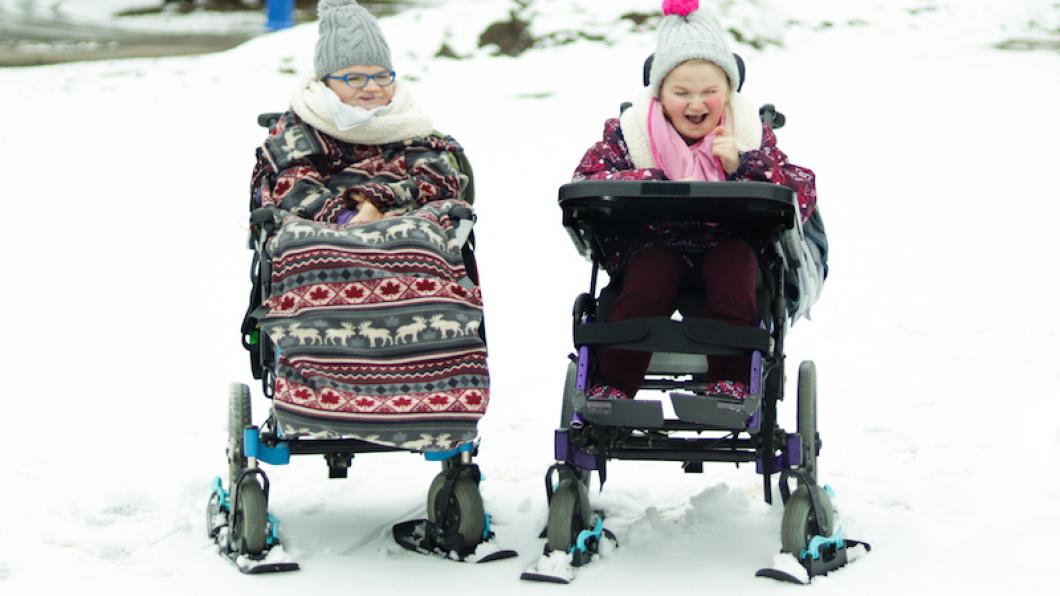
Snap-on wheelchair skis make getting out in the snow fun
Photo by Emily Pot @capturemily
By Louise Kinross
Social media is abuzz with parents talking about a great new lifestyle product: mini skis that lock beneath the wheels of a child's wheelchair, making treks across snow and ice much more enjoyable.
Wheelblades were invented by Patrick Mayer, an elite German freestyle snowboarder who became partially paralyzed after an accident. His Swiss company designs products for people with disabilities that increase their mobility on different surfaces. They're also marketed for use on strollers. Wheelblades can be purchased online at Amazon. They're also available from other suppliers, but appear to be out of stock in many places.
We reached out to Sara Pot in St. Catharines, Ont., after seeing a photo of her family using Wheelblades. Sara and husband Ralph have four daughters: Emily, 19; Sophia, 17; Rachel, 14; and Janneke, 11. Rachel and Janneke have Chitayat-Hall Syndrome. Sara graciously answered these questions via e-mail.
BLOOM: What kind of Wheelblades did you buy?
Sara Pot: We bought the Wheelblades XL. These are meant for strollers and wheelchair wheels. We bought one pair from a Canadian company based in Quebec, but they only had that pair in stock. We ended up buying our three additional pairs through Amazon (we would have preferred to buy from a small store). We were able to afford them through Ontario's Special Services at Home funding. With the limitations placed on most families on account of COVID-19, the Ministry created some freedom for SSAH families to purchase items that would support mental health and wellbeing at home.
BLOOM: Do they just go on the front wheels?
Sara Pot: Because we weren’t certain how well the chairs would move through the snow with just blades on the front, we bought two pairs for each daughter, allowing all four wheels to become skis. Other parents and individuals have shared that blades on just the front wheels works well. We will try out both options and determine the best solution for our girls over time. The product is so durable that if we don’t need all the blades, we could resell them.
BLOOM: How hard are they to put on?
Sara Pot: Once we measured the exact width of the wheels, we were able to adjust the blades to fit in a matter of minutes. The blades come in a large shoebox with a small tool for adjusting.
BLOOM: What difference do they make for taking your girls for a walk in the snow?
Sara Pot: So, far, we’ve noticed that the blades allow our girls time outside more often. Without the blades, we’d have to wait for everyone to shovel, or the roads to be plowed and clear. We are most excited about the walk to school—when in-person learning resumes—as I walk Janneke every day. Not everyone in our neighbourhood shovels, or at least shovels before 8 a.m. I have taken a shovel along with me previously, but obviously that's a ton of work that usually leads to frustration and getting stuck.
BLOOM: Can you go for walks that you wouldn’t normally be able to?
Sara Pot: In addition to the freedom of getting to school in the snow, we're also thankful to have the option to get outside more often, particularly during this season of COVID-19. Options for our girls were already limited pre-pandemic, so being able to access the outdoors as much as possible means enhanced quality of life and access to much-needed fresh air.
BLOOM: Any downsides?
Sara Pot: I suppose the downsides include the moments of having to slip them on, but it's really quite simple if you're the caregiver. Mind you, I can see how this might be a challenge for someone who is using them independently.
We also need snow!
We noticed it was more challenging to glide in the wet snow; those conditions might prompt us to simply use the blades on the front, so the back wheels can provide some traction and push. When the snow is cold and 'dry,' the skis slide beautifully. They also slide well over ice, which is often how our neighbourhood roads appear after a snowstorm, intermittent plowing and traffic.
BLOOM: What do the girls think of them?
Sara Pot: From what we can tell, they were amused by the experience. Both girls are are non-speaking, so we learn best from their body language and facial expressions. They love being outside, so getting out more often means they're happy, whether we wheel or glide.
BLOOM: Would you recommend them to other parents/people with disabilities?
Sara Pot: We learned of them through other parents sharing; word-of-mouth testimonials are ideal. I would recommend them—but I would explain they serve as an accessory. This means the blades will work when the conditions are right. They might not be used very often, and they aren’t meant for transportation in vehicles. I have no doubt there is risk in considering any sort of leisure activity such as sledding—but that doesn’t mean we haven’t enjoyed the small thrill of going over a snow-covered bump in the path.
The ones we have are designed for strollers—but based on the tire size, they were the best fit for our girls’ wheelchairs. There is a similar design for small front wheels found here.
In this video, a son and dad talk about their experience using Wheelblades.